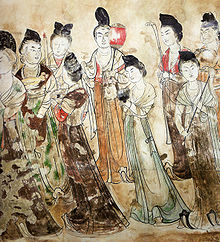

In China, women had different kinds of clothes in ancient times. Those clothes changed with the dynasty. For examples, in the 1920s, the Cheongsam was fashionable among socialites and upperclass women;[1] during the 1960s, very austere clothing styles were prevalent; today, a wide variety of fashions are worn. Different provinces and regions of China also have different clothing styles.
In Qin and Han dynasties, women usually wore loose clothes with long, large, sleeves. Under the long skirt was a pair of high-heeled clogs, usually with some embroidery on them. There was usually a scarf called Jinguo (巾帼) wrapped on the arm of a noble woman, while ordinary or poor women had no decoration on their arms. As time passed by, the coat tended to be shorter and the skirt became longer. Noble women even needed maids’ help to lift up the skirts, to avoid the skirts being stained by the ground.
In Sui and Tang dynasties, women's clothes had a trend of being more open. Small-sleeved coats, usually made of yarn, skirts that were still long, wide and long scarves were what was often worn. They could bare the part of their body above their chests. This sort of cloth could show the beauty of the women better. Another kind of clothes that were popular at that time were things with big sleeves, short breasted shirts and long and light skirts.
The attire of women during the Song dynasty (960 - 1279) was distinguished from men's clothing by being fastened on the left, not on the right. Women wore long dresses or blouses that came down almost to the ankle. They also wore skirts and jackets with short or long sleeves. When strolling about outside and along the road, women of wealth chose to wear square purple scarves around their shoulders.[2]
- ^ "Qipao (Ch'i-p'ao)". Encyclopædia Britannica. Retrieved 2008-11-18.
- ^ Gernet 1962, p. 129.